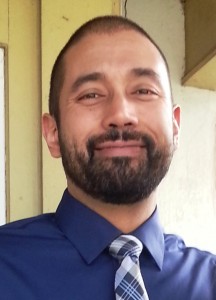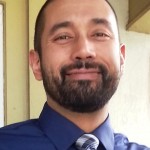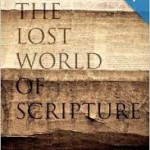 Today’s guest post is by Carlos Bovell, a frequent contributor to this blog (for a recent post go here and work backwards). Bovell is a graduate of Westminster Theological Seminary and The Institute for Christian Studies, Toronto. He is the author of Inerrancy and the Spiritual Formation of Younger Evangelicals (2007), By Good and Necessary Consequence: A Preliminary Genealogy of Biblical Foundationalism (2009), an edited volume, Interdisciplinary Perspectives on the Authority of Scripture (2011), and Rehabilitating Inerrancy in a Culture of Fear (2012).
Today’s guest post is by Carlos Bovell, a frequent contributor to this blog (for a recent post go here and work backwards). Bovell is a graduate of Westminster Theological Seminary and The Institute for Christian Studies, Toronto. He is the author of Inerrancy and the Spiritual Formation of Younger Evangelicals (2007), By Good and Necessary Consequence: A Preliminary Genealogy of Biblical Foundationalism (2009), an edited volume, Interdisciplinary Perspectives on the Authority of Scripture (2011), and Rehabilitating Inerrancy in a Culture of Fear (2012).
*****
Robert Yarbrough is a New Testament professor at Covenant Seminary, an inerrantist school, and served as president of the Evangelical Theological Society in 2013. He is the author of a commentary on 1, 2, and 3 John in Baker’s Exegetical Commentary of the New Testament series and also co-author of the textbook, Encountering the New Testament: A Historical and Theological Survey. He has recently published two articles (”The Future of Cognitive Reverence for the Bible,” and ”Should Evangelicals Embrace Historical Criticism? The Hays-Ansberry Proposal”) defending the importance of inerrancy.
My purpose here isn’t to disagree with Yarborough’s position. He is free to defend his understanding of scripture as inerrant as I am free to point out what I see are the problems with the concept.
I am more interested here in highlighting the unhelpful rhetoric Yarborough uses in both of the linked articles above, which I have found to be common among defenders of inerrancy:
Yarbrough presents three lines of argument for inerrancy’s continued importance.
- Theological: Inerrancy is theologically and biblically viable.
- Sociological: Inerrancy is what motivates students into biblical studies and into ministry.
- Historical: Inerrancy is what the world-wide church has always and still today believes.
On one level, those not disposed toward inerrancy should nevertheless take these considerations seriously. American evangelicalism made an inerrant Bible a core—if not the core—component of its theology. I feel we must be charitable and grant that, even if we disagree with the concept, the reasons for doing so were not entirely unfounded.
But that said, those who have doubts about inerrancy are not coming at their faith from a place where these arguments have much force, for we have come to experience personally that the spiritual life of churches and of believers is a journey and that the journey has to be “adaptable for life” (as James A. Sanders put it in his 1978 SBL presidential address) if it’s going to survive. (Thus the “aha” series on this blog describing some of the experiences.)
Despite Yarbrough’s assertions, an inflexible, all-or-nothing inerrantist doctrine of Scripture, impervious to change and development along the way, is hardly sound spiritual advice. For many believers, inerrancy as the default view of Scripture has already proven ill-equipped to handle biblical phenomena. It simply doesn’t allow for healthy adaptation, and in many cases will not permit needed growth in one’s faith—or in some cases even allow the faith to stay alive.
I don’t think the best way forward is to deny those experiences and strong arm Christians to adapt a paradigm they see as faulty.
To illustrate the differences in perspective between us, let me rephrase Yarbrough’s three points according to the questions I ask myself about the Bible:
- Theological: What is the best way to try to describe the Bible’s “authority”?
- Sociological: How has an “inerrant” Bible become so central to faith that it is thought to be what motivates believers to study scripture, go into ministry, remain a believer, etc.? If it truly is what’s motivating people, is this a good thing or does it suggest a deeper problem?
- Historical: How have Christian communities throughout the world and throughout history thought about their scripture, why have they done so, and what bearing does this have on the views we formulate today?
These are some of the questions I find myself asking and not only does Yarbrough not provide satisfactory answers to them, but his very style of defense does indeed seem to me “embarrassingly retrograde” (to use Yarbrough’s phrase in “Should Evangelicals?”).
Consider what theological advice Yarbrough might offer a student who has come to doubt inerrancy because of academic study of the Bible:
We can no more separate God and his words to us, if that is what Scripture is, than we can separate human friends and family from the words we exchange with each other. Neither God nor people we know are sphinxes whose identity we ultimately intuit by solely spiritual (or even Spiritual) means. To separate knowledge of persons’ identity, human or divine, from their verbal self-disclosure would in the end be both unproductive and perverse. (“The Embattled Bible,” 12)
Jesus regarded Scripture as words from God’s mouth. That should be understood analogically, of course, and not crudely literally, but the integral link between God and divine enscripturated speech remains. (“The Future of Cognitive Reverence,” 17)
This kind of answer would only be compelling for those who are satisfied with inerrancy as the default view. Not only is Yarbrough’s rhetoric here not persuasive, but it comes across as strong arming and emotionally manipulative.
Post-inerrantists are not trying to sever the relationship between God and scripture but rather to establish it by critically investigating scripture and conceptually clarifying it. It is not “perverse” or “unproductive” when a believer suspends judgment on inerrancy, takes a searchingly fresh look at the Bible, and concludes that inerrancy simply does not do justice to what the Bible is and how the Bible behaves.
Given the significant number of thinking people who have left inerrancy (as opposed to moving toward inerrancy from a non-inerrantist position), dismissing this scenario as invalid or spiritually stunted, or minimizing the experiences of those who have walked this path by rhetorically pitting them against the “faithful” who have not walked that path, is pastorally unwise and harmful.
Next: How has an “inerrant” Bible become so central to faith that it is thought to be what motivates believers to study scripture, go into ministry, remain a believer, etc.? If it is what’s motivating people, is this a good thing?
In Yarbrough’s view, it’s the reliability of scripture that led a large percentage of ETS members to go into ministry and scholarship. Is it, really? Has inerrancy really always been so central to Christian faith and the motivator for most Christians to study scripture, go into ministry or be a believer? Or has the true motivation come from the love of God in Christ for us and ours for him?
If inerrancy is what is motivating some to believe, perhaps they have misplaced their first love, or even allowed scripture to substitute for God. As I explain in Rehabilitating Inerrancy in a Culture of Fear, we come to scripture already immersed in God’s Spirit. It’s because of God’s love for us and ours for him that we read and meditate on scripture in the first place not the other way around.
Third: How have Christian communities throughout the world and throughout history thought about their scriptures, why have they done so, and what bearing does this have on the views we formulate today?
Yarbrough continues to appeal to Woodbridge’s claim that modern day inerrancy is the historic position of the Christian churches through history. No thought is given, however, to the overwhelming changes that have occurred in the ways we see the world today and what we know about scripture today.
Our views of scripture had better be different in many respects from how the ancients thought about scripture—and indeed they are.
And when examining what the ancients did say with respect to their views of scripture, we must keep in mind that even when they use language similar to ours (“no errors”), the church hasn’t always meant the same thing by it, nor does it mean that the ancients are poised to adjudicate for us the pressing challenges of modernity. We cannot simply appeal to ancient voices to settle or table current challenges.
One thing to notice is that the questions post-inerrantists tend to ask and the arguments inerrantists like Yarbrough tend to put forth speak to two different sets of concerns.
Post-inerrantists are trying to find ways to adapt their faith to keep their journeys going, while inerrantists are trying to make sure journeys stay in line with what they perceive to be historic, orthodox faith, and that insists on inerrancy as defined by the Chicago Statement.
When it comes down to it, both groups are grappling with how to deal with change.
I suggest that at least part of what keeps the latter from giving their blessings to what the former is trying to do is a culture of fear that defines parts of inerrantist evangelicalism. (See my chapter on Bart Ehrman in By Good and Necessary Consequence: A Preliminary Genealogy of Biblicist Foundationalism and also Rehabilitating Inerrancy in a Culture of Fear.)
I say this based primarily on personal experience within inerrantist culture, but it also comes up in some writings by inerrantists themselves when they defend their position. We hear that too much is at stake to yield to criticism, and as long as there are inerrantists scholars around who can defend it as a plausible or possible view, a believer need not worry about making any changes to inerrantist doctrine.
Yarbrough not only asserts that the historical church held to inerrancy, but that the global church does to. Although he presents the point as an afterthought, I wonder whether it plays a larger role:
The history of movements sacrificing the whole truth of the whole Bible for the sake of extending an olive branch to parties not committed to the whole range of historic Christian conviction (God not being a piecemeal God) is not encouraging. . . . not to mention the disastrous pastoral and missiological implications of church leaders. . . suddenly announcing to Bible-honoring congregations, or proclaiming to the lost in the post-Christian West, to Muslims in the Middle East, or to Hindus in India (or anywhere), that the Christian Bible long claimed to be true by the ‘Church’ is now known to be, well, substantially less so. But believe our testimony to Christ (testified to historically almost no where else besides this Bible) anyway! (“Should Evangelicals Embrace Historical Criticism?” 50–51).
In other words, inerrantists have been insisting to everyone for decades that the Bible is inerrant, imagine what would happen if we changed our minds now.
This is an appeal to emotion such that if believers want to support what missionaries are trying to do, they must hold on to inerrancy lest they undercut their efforts. But the perceived centrality of inerrancy among missionaries, wherever that might be, speaks not to the actual centrality of (western) inerrancy but to how these missionaries were taught to think about scripture, which, in turn, passed it on to their congregations.
Yarbrough and other inerrantists at ETS will continue defending the centrality of inerrancy for the spiritual life. But for those who have already experienced the change authentically from within their journey, Yarbrough’s defense rings hollow at best, and appears emotionally manipulative at worst.










